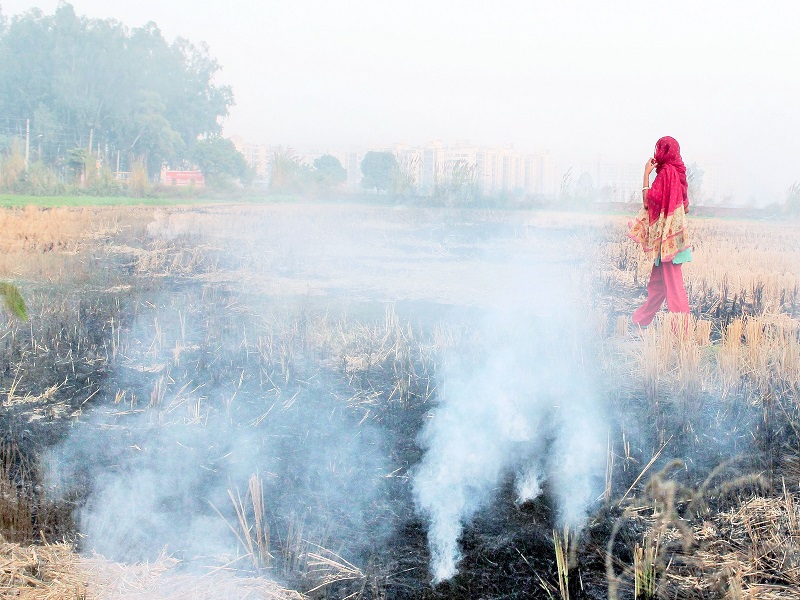Delhi’s air pollution season is starting with the burning of rice stubble by farmers on lakhs of acres after the kharif harvest. It’s politically impossible to stop a traditional practice like burning through legal bans: farmers think they have a right to burn, whatever the ecological consequences The solution lies in finding profitable ways to use the rice stubble. Of these, the most intriguing is the conversion of stubble into goat fodder.
Burning stubble destroys a useful raw material, pollutes the air, causes respiratory diseases and worsens greenhouse gas emissions. Traditionally, rice was harvested manually. But today’s farm labour shortage means combine harvesters now cut most of the kharif crop in the north-west. Manual cutting leaves only a couple of inches of stubble, but combine harvesters leave 12-15 inches.
Once, farmers allowed shepherds to graze sheep on the stubble. But today farmers are in a rush to clear the fields and plant a rabi crop within a fortnight of the kharif harvest. Cutting and transporting stubble can cost Rs 1,200 per tonne, and few buyers will pay so much. Hence most farmers simply burn the stubble.
Multiple approaches are needed to discourage burning. Zero-till farming, for instance, sows wheat seeds without removing the stubble. A promising new machine is the tractor-mounted Happy Seeder that simultaneously cuts rice stubble and sows wheat seeds, depositing the cut stubble on top as a mulch. This eliminates burning, but carries additional costs. Hence farmers, who are risk-averse, mostly stick to burning. To catalyse change, a promotional tax break for Happy Seeder machines can be given for, say, five years. This will help spread awareness of the new technology and popularize its use. Some studies suggest that with some new tweaks, it may also increase yields.
Punjab has a pilot project using straw as fuel for power generation. But that loses money right now. It pays farmers less for straw than other users such as the packaging and paper industries. Neither demand nor the price of straw suffices today to discourage burning.
The best use of stubble is as animal feed. Over 100 million tonnes of stubble is burned today. Converting that into milk and meat will add more value than using it as fuel. Problem: rice straw has high silica content, reducing its digestibility. Hence only 30% of rice straw is used today as fodder, against 70% of wheat straw. Both rice and wheat straw have a high lignin content that also hampers digestion.
Humans cannot digest straw at all, but ruminants (cattle, sheep, goats) have four-stage stomachs that digest up to half of it. Goats have the toughest stomachs and best digestion rates. They are famous for aggressively eating almost anything. So, goat feed is potentially the best use of rice straw.
Traditionally, goats were grazed in village pastures and forests. Shrinking grazing space has reduced the goat population. Forest grazing must be stopped, as it thwarts regeneration. The future lies in stall feeding: animals are kept in stalls and fed a mixture of straw, oilcakes and cereals. Treatment with urea, alkalis or molasses can improve the digestibility (and hence calorific value) of straw.
Stall feeding is obviously more costly than free grazing. But it has advantages too. The energy animals spend in grazing uses up to one-third of their calorie intake. This is avoided by stall feeding, so stall-fed animals produce significantly more milk and meat than those that graze.
Operation Flood has hugely increased milk production and the cattle population. But nothing similar has been done for goats, although goat meat is the most prized, and goat milk has buyers. Cows produce only one calf, whereas goats produce three to six kids, which mature much faster than calves. A goat costs one-tenth as much as a buffalo and so is affordable even by poor villagers, apart from being hardier and less disease-prone.
India needs a goat revolution to match Operation Flood. This requires much R&D and incentives for stall feeding. These can be combined with short-run moves, of which the simplest will be a tax break or subsidy, funded by green levies, for fodder processors that upgrade the nutritional value of straw by adding urea or molasses. This can immediately make stubble harvesting more profitable, checking burning and reducing the brown haze that chokes Delhi and the north-west. This can supplement other anti-pollution measures to reduce road dust, construction dust and vehicle emissions.


